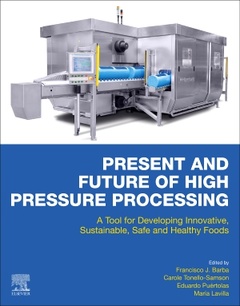Description
Present and Future of High Pressure Processing
A Tool for Developing Innovative, Sustainable, Safe and Healthy Foods
Coordinators: Barba Francisco J., Tonello-Samson Carole, Puértolas Eduardo, Lavilla María
Language: English
Subjects for Present and Future of High Pressure Processing:
426 p. · 19x23.3 cm · Paperback
Description
/li>Contents
/li>Readership
/li>Biography
/li>Comment
/li>
This book specifically focuses on innovative high-pressure processing applications and begins with an introduction followed by a section on the impact of high-pressure processing on bioactive compounds and bioaccessibility/bioavailability. The third section addresses the ways in which high-pressure processing can assist in the reduction of toxins and contaminants, while the fourth section presents opportunities for the use of high-pressure processing in the development of healthy and/or functional food. This reference concludes with an analysis of the challenges regarding the use of high-pressure processing as an innovative application.
Section 1. Introduction 1. An overview of the potential applications based on HPP mechanism
Section 2. Impact of HPP on bioactive compounds content and bioaccessibility/bioavailability 2. HPP for improving preservation of vitamin and antioxidant contents in vegetable matrices 3.Impact of HPP on probiotics: Kinetic and metabolic profiling study of yogurt produced under different pressure conditions 4.Impact of HPP on the bioaccessibility/ bioavailability of nutrients and bioactive compounds as a key factor in the development of food processing
Section 3. Reduction of toxic/contaminants assisted by HPP 5. HPP impact to reduce allergenicity of foods 6. Effect of high-pressure thermal sterilization (HPTS) on the reduction of food processing contaminants (e.g., furan, acrylamide, 3-MCPD-esters, HMF) 7. The potential of HPP for minimizing pesticides and toxins in food products
Section 4. Opportunities of HPP in healthy and/or functional food development 8. HPP as an innovation tool for healthy foods 9. HPP in seafood products: Impact on quality and applications 10. High-pressure processing (HPP) of meat products: Impact on quality and applications 11. HPP in dairy products: Impact on quality and applications 12. HPP of fruit and vegetable products: Impact on quality and applications
Section 5. Challenges of HHP in innovative applications 13. Advances in high-pressure processing in-pack and in-bulk commercial equipment 14. High hydrostatic pressure-assisted extraction: A review on its effects on bioactive profile and biological activities of extracts 15. Application of HPP in food fermentation processes 16. Strategies for development of new ingredients and food products based on HHP-induced changes in rheology 17. An introduction to packaging for commercial high-pressure processing (HPP) applications
Food technologists, food nutritionists, food processors, agricultural engineers, R&D managers and/or new product developers, graduate and post-graduate students studying food science, nutrition, gastronomic science, and food processing
Nowadays, Dr. Barba is serving as Associate Editor of the prestigious Journals “Food Research International, "Journal of Food Composition and Analysis", "Journal of Food Processing and Preservation", “Molecules and "Frontiers in Nutrition", among others.
Dr. Carole Tonello-Samson is active industrial researcher with emphasis in High Pressure Processing (HPP) for food. She studied biochemistry and food technology in France. In 1996, she obtained a PhD in food science on the effects of HPP on inactivation of microorganisms. For five years, she was been R&D manager in a R&D centre focused on HPP for food (Hautes Pression
- Explores the use of high-pressure processing as a tool for developing new products
- Outlines the structure and improved functional properties provided by high-pressure processing
- Illustrates potential applications and future trends of high-pressure processing
- Explains the mechanisms that influence the impact of high-pressure processing
- Highlights the optimal conditions for high-pressure processing to develop certain food products
- Defines the challenges and future perspectives in the use of high-pressure processing for food product development




